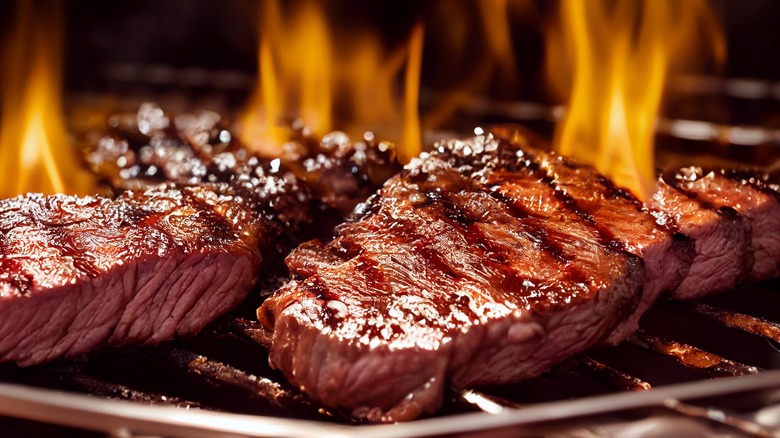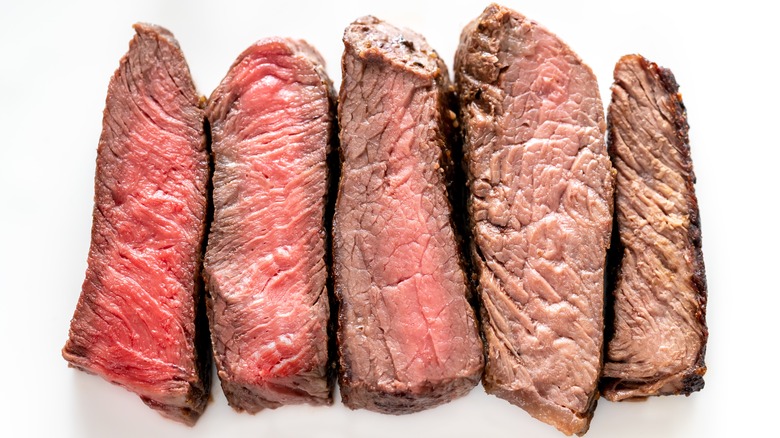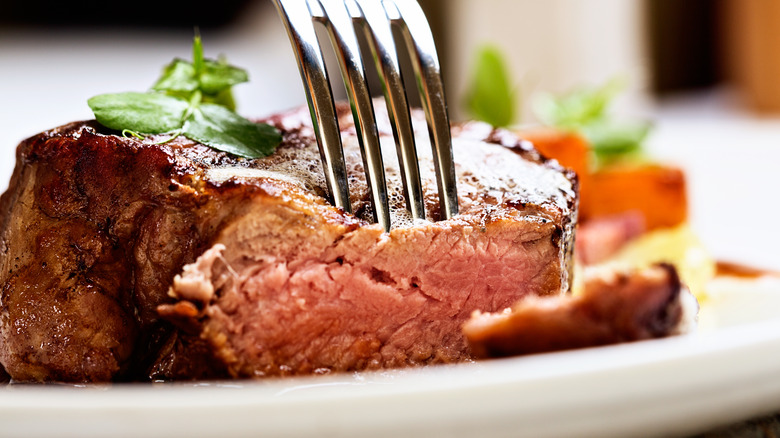Why You Should Check Steak Temperatures With A Cake Tester
Don't let its name fool you, a cake tester is actually fantastic at more than just testing baked goods; it can tell you when savory roasts are ready, too. While professional kitchens have long put the thin metal skewers to work testing the temperature of beef, now, home cooks are catching on to the secret and snapping up the affordable tool. At less than $10 for a multi-pack, there's very little downside to adding a handful to your kitchen drawers.
They're particularly helpful when it comes to cooking steak. Though there are visual cues to tell when a steak is perfectly cooked, a cake tester helps check the meat's internal temperature to get a rough sense of its doneness (though it won't be as precise as an actual temperature from a meat thermometer).
To use the tester at home, you'll want to insert the metal side into the center of the meat. Leave it there for a handful of seconds, then remove it and place the skewer against your skin — many prefer to place it on the sensitive part of their wrist, bottom lip, or the skin below their lips for an accurate assessment. The heat the tester absorbs from a steak will clue you into its doneness and tell you how hot the center of the meat is (i.e., the warmer the metal, the more cooked it is).
Decoding steak with your cake tester
There are a few rules of thumb to help you understand the reading of a cake tester when using it on steak. If the metal feels cool to the touch, the heat hasn't penetrated much of the meat's center and it will likely be rare. If you're aiming for medium-rare, you'll want the tester to feel similar to the temperature of your skin. A well-done steak will have a very hot center, so test with caution.
Using these helpful skewers also allows you to minimize the number of times you cut into the center of the steak to check it. That means less juice escapes, your protein looks prettier, and you don't have to waste time slicing and testing. Instead, you get quick guidance to help keep your sear on track.
Though there are some moments when you'll still need to call upon a meat thermometer, employing a cake tester will become easier the more often you do it. Consider the skewers to be additional tools in your arsenal, rather than a replacement for the digital gauge. They'll help you build confidence in the kitchen and ultimately develop a more instinctive sense of when your steak is perfectly done.
A built-in texture tester
Line cooks often skewer, poke, and stab more than just cake and steak with the testers. Many proteins and vegetables can benefit from a quick cake tester check — except for chicken, which is best to test with a food thermometer to ensure it's safely cooked through. That's because the metal offers helpful insight into not only the temperature of your food, but its texture, too.
Instead of prodding roasted veggies or meats with a knife, you can feel if your ingredient is soft and tender with the poke of a skewer. Restaurant cooks use the tool to gauge everything from fish to potatoes. Plus, it leaves very little trace compared to fork tines, which means your food stays intact no matter how many times you check it.
Vegetables are often a matter of taste and are dependent on the recipe, so you may want a bit of resistance in your broccoli. For fish, however, you should be able to poke through the fillet with ease. Just like when you test with a fork or knife, you'll come to recognize the texture you're looking for with practice. You can also use the steak testing technique and check the temperature for more insight.



